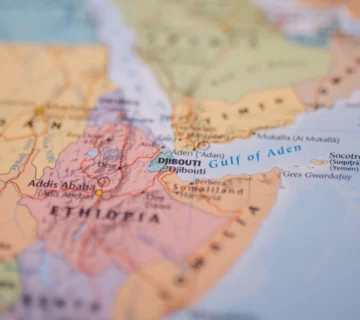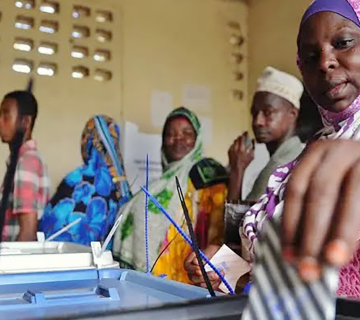Resource curse refers to the paradox of underdevelopment and poverty in otherwise resource-endowed countries, mostly in the developing world. In Africa, many resource-rich countries suffer this curse to the extent that natural resource exploration is more harmful than good to them. The curse is largely associated with the poor socio-economic conditions that exist in the affected countries especially in the developing world. Therefore, it is important to analyze resource curse within political economy frames of these countries.
In these countries, conditions are normally worse in resource deposit regions. For instance, communities around mines, oil wells, and other mining sites experience unemployment, poverty, low education levels, poor environmental health, and generally, low quality of life. In some instances, locals face displacement as exploration activities take root. These conditions are then politicized by local groups, who build grievances and if state response does not address them, these groups form movements to oppose what they call exploitation of local resources.
With the discovery of oil in Turkana in 2012, the county earned a premier economic status in Kenya’s economic development dream. However, as exploration begun, wrangles between national government and Turkana county leadership also arose. First, it was over oil revenue sharing formula between the national government and the county government of Turkana. These wrangles were aggravated in 2017 by a public showdown between Turkana governor, Josephat Nanok and president Uhuru Kenyatta during a political rally in the county, ahead of August 2017 elections. This problem was resolved this year at 75 per cent for the national government, 20 per cent for the County government and five per cent for the local community.
However, in June 2018, Turkana residents invaded Ngamia 8 oil well paralyzing operations at the facility. On June 28, 2018, Turkana residents again took to Lokichar- Kitale highway and blockaded oil trucks at Kalemgorock from transporting crude oil from the county to Mombasa. They blockaded the trucks for almost a week threatening the prospects of Early Oil Pilot Scheme.
(EOPS). This came after the national government had already spent Ksh 200 billion on this phase and it is planning a further Ksh 300 billion pipeline. The blockading protesters demanded job and tender opportunities at oil drilling sites. They also complained against the general state of insecurity which they blamed on banditry in the region. The national government had since created an Administration Police camp at Noosukro that also hosts the Rapid Deployment Unit to help deal with banditry. The state responded by arranging a regional security meeting with Turkana political leaders comprised of Members of County Assembly, Members of Parliament, and the governor. The blockade has been resolved following the security meeting.
In the short term, the national government through relevant the ministry should lay out a framework of addressing local demands for jobs, tenders and higher oil revenue. This process should be as participatory as possible for amicable resolution of local demands. If possible, it should remain a continuous process in view of possible contingencies. Leaders from the County should also take the responsibility of promoting peaceful dispute resolution mechanisms. They should continuously engage with their constituents on contentious issues for participatory outcomes. Turkana’s possible ‘oil curse’ will persist if the government does not fully commit to resolving local demands.
It is also important to note that the developing security situation in Turkana County around oil drilling in the county is intertwined with historical factors that shape the social and political terrain of the region. To sustainably address the situation, Turkana County should not be isolated from neighboring Baringo, Samburu, Pokot, Elgeyo Marakwet, and Isiolo counties. The region, Northern Kenya, comprising of these counties has almost similar historical experiences that need a comprehensive remedial approach.
Real or perceived marginalization in the region including Turkana County is permissive to the law and order in the region. Civil dispute resolution mechanisms should also be advanced alongside sustained grass-roots peacebuilding initiatives. Finally, investment in infrastructural development in the region should be expanded by both public and private sectors. Such investments should target roads, electricity, water, and telecommunications.
Banditry in the region, highly blamed on cattle rustling will be partly addressed by the foregoing regional development programs. They will address socio-cultural, economic and political conditions permissive to banditry in the region. However, the security aspect of the problem requires another approach since it is both local and trans-boundary in nature.
The proliferation of Small Arms and Light Weapons (SALWs) feeds banditry and general insecurity in the region. The porous borders of Kenya and neighboring Uganda, Ethiopia, South Sudan, and Somalia play a big role in the proliferation of SALWs in the region (Turkana and neighboring counties). Kenya has carried out numerous disarmament exercises and operations in Turkana and neighboring Counties. Tens of thousands of SALWs have been collected and destroyed over decades according to Kenya National Focal Point on Small Arms (KNFP). This problem needs to be effectively addressed to prevent escalation of local conflicts to a level of becoming great security, economic, and political menace to Kenya.
Effective, structured, facilitated, and coordinated regional efforts towards disarmament, control and monitoring of the trade and flow of SALWs should be mounted by regional governments. Similar efforts should also be accorded to prevent, combat and eradicate cattle rustling. Instruments such as the 2004 Nairobi Protocol on Prevention, control and reduction of Small Arms and Light Weapons in the Great Lakes Region and the Horn of Africa, the 2005 Nairobi Protocol on Best Practices and the Protocol on the Prevention, Combating and Eradication of Cattle Rustling of 2008 are crucial to this end. Regional governments and state parties to these protocols should create structures for coordination and implementation, and devote technical, diplomatic and financial resources for their effective operationalization.



